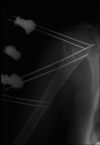How to improve the outcomes of surgically treated proximal humeral osteoporotic fractures? A narrative review
- PMID: 32922699
- PMCID: PMC7461645
- DOI: 10.4081/or.2020.8529
How to improve the outcomes of surgically treated proximal humeral osteoporotic fractures? A narrative review
Abstract
Proximal humeral fractures (PHF) are the third most common non-vertebral fragility fractures after hip and distal radius. It still controversial which treatment might be more appropriate, and surgically treated outcomes depends also on an appropriate technique. In order to clarify surgical indications, tips and pitfall a narrative review was conducted. Pinning, external fixation, plating and internal fixators has each one its advantages and disadvantages. During the procedure an appropriate use of the fixation device and handling of the soft tissue might be associated with better outcomes. Calcar comminution, varus angulation, medial dislocation of the shaft, fracture-dislocation are factors that could lead to choose a replacement. Hemiarthroplasty and reverse total shoulder arthroplasty are the most common prosthesis used in PHF. The restoration of humeral length and tuberosities might lead to an improvement in clinical outcomes and prosthesis survivorship.
Keywords: Fragility fracture; Locking plate; Osteoporosis; Proximal humeral fracture; Shoulder arthroplasty.
©Copyright: the Author(s).
Conflict of interest statement
Conflict of interest: The authors declare no potential conflict of interest.
Figures




References
-
- Jobin CM, Galatz LM. Proximal Humerus Fractures: Pin, Plate, or Replace? Semin Arthroplasty 2012;23:74–82.
-
- Palvanen M, Kannus P, Niemi S, Parkkari J. Update in the epidemiology of proximal humeral fractures. Clin Orthop Relat Res 2006;442:87–92. - PubMed
-
- Court-Brown CM, Caesar B. Epidemiology of adult fractures: A review. Injury 2006;37:691–7. - PubMed
-
- Robinson CM, Stirling PHC, Goudie EB, et al. Complications and Long-Term Outcomes of Open Reduction and Plate Fixation of Proximal Humeral Fractures. J Bone Joint Surg Am 2019;101:2129–39. - PubMed
LinkOut - more resources
Full Text Sources

